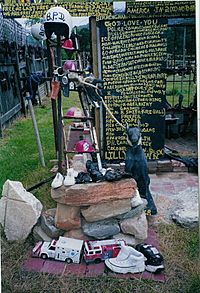Joe Minter facts for kids
Quick facts for kids
Joe Minter
|
|
|---|---|
| Born |
Joe Wade Minter Sr
March 28, 1943 |
| Nationality | American |
Joe Minter (born March 28, 1943) is a talented American artist from Birmingham, Alabama. He is famous for creating amazing sculptures from old metal and other found objects. His biggest project is called African Village in America. It's a special outdoor art space that tells the story of African American history, from the very first people brought to America to today. Joe Minter's art has been shown in big museums like the National Gallery of Art and the Metropolitan Museum of Art.
Contents
Joe Minter's Early Life
Joe Minter was born in Birmingham, Alabama, in 1943. He was one of ten children in his family. His father worked as a caretaker for a cemetery for many years. Joe went to school in Birmingham. In 1965, he joined the military and served until 1967.
After his military service, Joe worked many different jobs. He worked with metals, built school furniture, and helped build roads. Because of his work, he had some eye problems. This made him retire from his jobs. After retiring, Joe Minter started making art again, something he had enjoyed since he was a child.
Joe Minter's Art and Creations
The African Village in America
Joe Minter's most famous artwork is the African Village in America. It is located in Birmingham, Alabama. He started building it in the late 1980s and has worked on it for over thirty years. This special place is like an outdoor museum and a memorial.
The African Village in America is always growing and changing. Joe creates sculptures from all kinds of old and discarded items. He uses things like old shoes, toys, sports equipment, and even baking tools.
The main idea behind Joe's art is to honor the history of African Americans. He wants to remember the 388,000 Africans who were brought to America long ago. He also celebrates their descendants who helped build and protect America. The sculptures tell many stories, from ancient African warriors to important events like the 1963 bombing at the 16th Street Baptist Church.
Where You Can See His Art
Joe Minter's sculptures have been shown in many important art exhibitions. His work is also part of the permanent collections in major museums. This means his art is kept there forever for people to see.
- National Gallery of Art, Washington, D.C.
- Metropolitan Museum of Art, New York, NY
- Smithsonian American Art Museum, Washington, D.C.
- Fine Arts Museums of San Francisco, San Francisco, CA
- High Museum of Art, Atlanta, GA
- Birmingham Museum of Art, Birmingham, AL
- Minneapolis Institute of Art
Some of his notable exhibitions include:
- 2022 – Called to Create: Black Artists of the American South at the National Gallery of Art
- 2019 – Whitney Biennial at the Whitney Museum of American Art
- 2018 – History Refused to Die: Highlights from the Souls Grown Deep Foundation Gift at the Metropolitan Museum of Art



